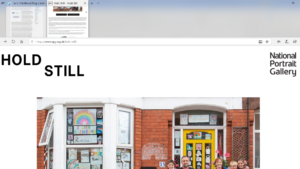
This post is written by Karen Douthwaite who is an Associate Lecturer in Early Childhood here at the Open University.
2020, a year like no other, has seen us adopt new ways of living, in which maintaining distance has been key to our physical health, but has doubtless been a strain on our emotional well-being. As adults we have grappled with the need to keep apart from the people and activities we love, swayed by the ‘science’ that in doing so we protect the lives of others. For our youngest citizens, the daily graphs that represent our predicament, offer little comfort for their changing worlds where their nurseries have closed and grandparents have remained behind closed doors. As we as adults have maintained our connections through phone calls and webchats, how can we understand the ‘new normal’ that is experienced by our very young and pre-verbal children, or know whether they continue to thrive and be emotionally well?
These are questions that some of our second year Early Childhood students at the Open University have been considering by exploring images of children in the Hold Still exhibition hosted by the National Portrait Gallery to capture our lives in lockdown. Woven amidst the images of health-workers, home hair-cuts and painted rainbows, are images of children making sense of their changing worlds. We see a one-year old boy beaming around the edges of his dummy as he touches the window where he can see his grandmother, lips pressed towards him; a scene his mother titles ‘glass kisses’. In one image, two young children occupy a small balcony on a second floor flat, sharing their only outdoor space with a line of washing, as they read books and soak up the sunshine. My favourite perhaps, is an image of 4-year-old Isobel sleeping soundly in her bed next to an I-pad on which Grandma can be seen reading a bedtime story. New norms, new ways of maintaining meaningful relationships.
Through their studies, our students will be reflecting on the importance of listening to children as active contributors to society, and considering the merits of different methodologies for tuning into children’s perspectives to co-construct ideas in which their views hold value. Approaches, for example such as those promoted in the city of Pistoia in the Tuscan region of Italy. Here, documentation such as children’s drawings and work, as well as photographs and narratives of their play, act as a ‘window and a mirror’ making children’s learning visible to the whole community (Barr and Drury, 2017 p3). Or perhaps Alison Clark’s ‘Mosaic approach’ in which children, valued as skilled communicators, take their own photographs and give detailed accounts of their everyday experiences, creating a picture that enables adults and children to learn together (Clark, 2017). Indeed, images submitted for the Hold Still exhibition were submitted by photographers as young as 4-years old.
The exhibition gives us a starting point for connecting with young children’s perspectives of lockdown, and if we could build a mosaic around these by interviewing the children and their parents, observing their actions and exploring children’s own documentation, what could we learn – both about them, and from them? I would like to ask Isobel what her favourite stories are to share with Grandma, and how characters can come alive over the internet. I would ask the children on the balcony how small spaces can become a rewarding place for learning, and I would ask one Mum how much our spirits can be lifted by making time for glass kisses.
Let’s keep listening and learning together…
References
Barr, M. and Drury, R. (2017) ‘” Documentation” in Pistoia preschools: A window and a mirror’, International Research in Early Childhood Education, 8 (1) pp. 3-20.
Clark, A. (2017) Listening to young children: a guide to understanding and using the mosaic approach. London: Jessica Kingsley.
